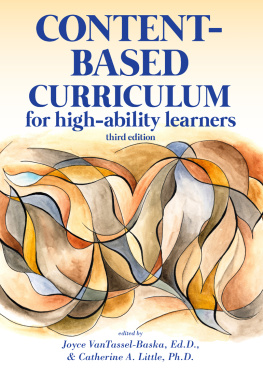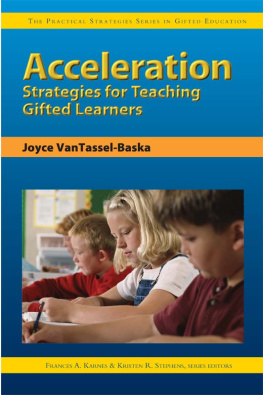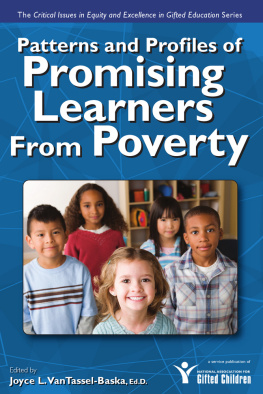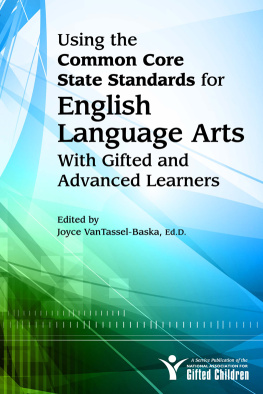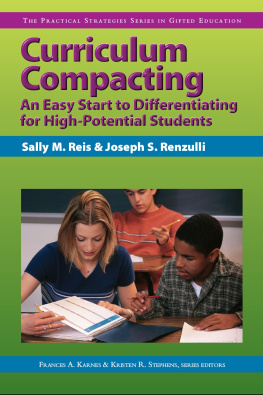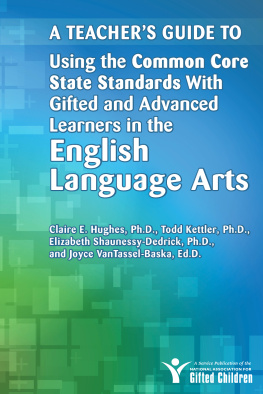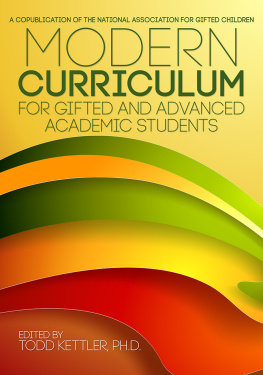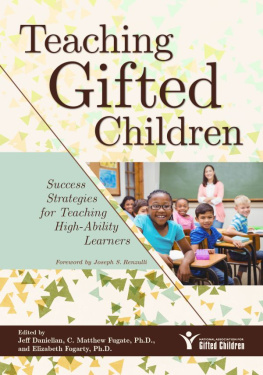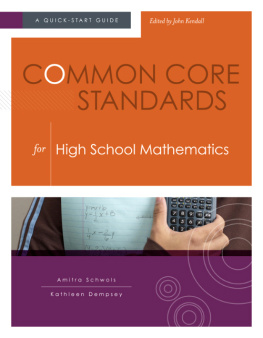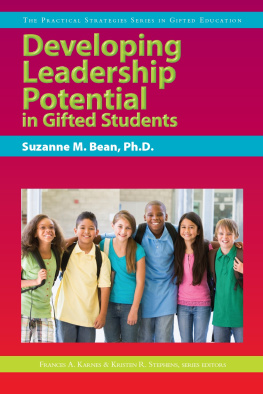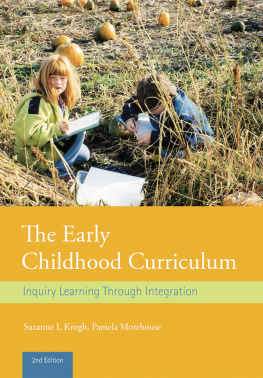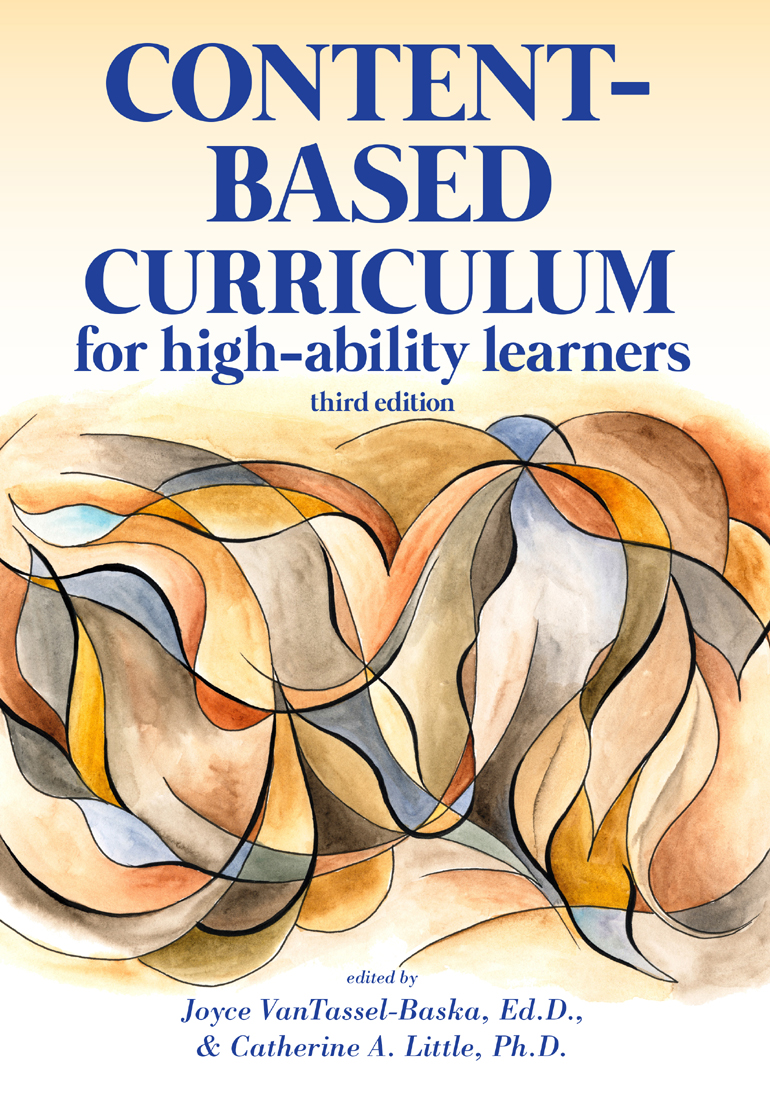
CONTENT
BASED
CURRICULUM
for high-ability learners
third edition
CONTENT
BASED
CURRICULUM
for high-ability learners
edited by
Joyce VanTassel-Baska, Ed.D.,
& Catherine A. Little, Ph.D.

Dedication
To all the teachers who have used the ICM and resultant products in
their classrooms to support advanced learning over the past 25 years.
Library of Congress catalog information
currently on file with the publisher.
Copyright 2017, Prufrock Press Inc.
Edited by Lacy Compton
Cover and Layout Design by Raquel Trevino
ISBN-13: 978-1-61821-592-5
No part of this book may be reproduced, translated, stored in a retrieval system, or transmitted, in any form or by any means, electronic, mechanical, photocopying, microfilming, recording, or otherwise, without written permission from the publisher.
At the time of this books publication, all facts and figures cited are the most current available. All telephone numbers, addresses, and website URLs are accurate and active. All publications, organizations, website, and other resources exist as described in the book, and all have been verified. The authors and Prufrock Press Inc. make no warranty or guarantee concerning the information and materials given out by organizations or content found at website, and we are not responsible for any changes that occur after this books publication. If you find an error, please contact Prufrock Press Inc.

| Prufrock Press Inc.
P.O. Box 8813
Waco, TX 76714-8813
Phone: (800) 998-2208
Fax: (800) 240-0333
http://www.prufrock.com |
Table of Contents
Chapter 1Introduction to the Integrated Curriculum Model
Joyce anTasselV-Baska
Chapter 2Characteristics and Curricular Needs of Advanced Learners
Elissa F. Brown
Chapter 3Curricular Considerations for Advanced Learners From Low-Income and Minority Backgrounds
Joyce VanTassel-Baska
Chapter 4Curricular Considerations for Advanced English Language Learners
Susan Dulong-Langley
Chapter 5Curricular Considerations for Twice-Exceptional Learners
Claire E. Hughes
Chapter 6The Role of Acceleration for Advanced Learners
Joyce VanTassel-Baska
Chapter 7Applying Higher Order Process Skills to Curriculum for Advanced Learners
Tamra Stambaugh and Catherine A. Little
Chapter 8Developing Authentic Products Through the Integrated Curriculum Model
Joyce VanTassel-Baska
Chapter 9The Use of Overarching Concepts in the Integrated Curriculum Model
Catherine A. Little
Chapter 10Curriculum-Based Assessment for Advanced Learners
Joyce VanTassel-Baska
Chapter 11Language Arts Curricular Considerations for Advanced Learners
Catherine A. Little
Chapter 12Mathematics Curricular Considerations for Advanced Learners
Dana T. Johnson
Chapter 13Science Curricular Considerations for Advanced Learners
Alicia Cotabish
Chapter 14Social Studies Curricular Considerations for Advanced Learners
Molly M. Sandling
Chapter 15Curricular Considerations in World Languages for Advanced Learners
Bronwyn MacFarlane
Chapter 16Curricular Considerations for Advanced Learners in the Arts
Hope E. Wilson
Chapter 17The School-Based Psychosocial Curriculum Model
Tracy L. Cross, Jennifer Riedl Cross, and Lori Andersen
Chapter 18Teaching Leadership Skills to Gifted Learners: Lessons in Tomorrow
Joyce VanTassel-Baska
Chapter 19Learning From and Learning With Technology
Del Siegle, Christina M. Amspaugh, and Melissa S. Mitchell
Chapter 20Professional Development to Support Successful Curriculum Implementation
Catherine A. Little and Kristina Ayers Paul
Chapter 21Aligning Curriculum for the Gifted With Content Standards and State Assessments
Tamra Stambaugh and Joyce VanTassel-Baska
Chapter 22Beyond K12: Honors Curriculum for High-Ability College Students
Jennifer Lease Butts, Jaclyn Chancey, and Catherine A. Little
Chapter 23Using the Integrated Curriculum Model to Address Social, Emotional, and Career Needs of Advanced Learners
Susannah M. Wood and Erin M. D. Lane
Chapter 24Conclusion: Implementing Innovative Curriculum and Instructional Practices in Classrooms and Schools
Joyce VanTassel-Baska and Catherine A. Little
Acknowledgements
The editors would like to express our appreciation for the assistance of Kelly Shea and Alyssa Schwager, graduate students at the University of Connecticut. Their work helped to make this new edition possible.

Preface
I am honored to write the preface to the third edition of Joyce VanTassel-Baska and Catherine Littles book, Content-Based Curriculum for High-Ability Learners. Joyce introduced me to the field of gifted education when she came to Northwestern University in 1981, and I immediately knew that I had befallen upon a great opportunityto be guided by a person who was so passionate about gifted education and respected in the fieldwho could serve as a role model for me professionally and personally. Under Joyces guidance, I also became a passionate advocate for gifted education.
Joyce and Catherines work on curriculum, including both conceptual pieces and William & Mary curricula for students, has been a major contribution to the field of gifted education, and this third edition continues that tradition.
The first edition of this book came out in 2003. The very title was significant at that time as it emphasized content and learning within domains. Too much of gifted programming had been content-lessemphasizing skills in the absence of challenging, substantive subject matter. The book chapters put a clear focus on how important it was to understand how domains of knowledge are structured and the major concepts and theoretical frameworks within domains, as these have implications for instruction and how acceleration and enrichment are designed and implemented for gifted learners.
Joyce, along with others, chose the name Center for Talent Development for the gifted education center she began at Northwestern decades ago. Now, those wordstalent developmenthave taken on greater meaning and refer to a conceptual framework for gifted education services. Joyce and many of her contemporaries were moving the field of gifted education into a more domain-focused approach 35 years ago, but timing is everything and talent development is only now beginning to take hold as a structure for identification, programming, curriculum, and instruction for gifted children.
There are some notable changes in the collections of chapters from editions 1 to 2 to 3 that reflect this shift toward talent development in the field. For example, there were more chapters devoted to specific content areas in edition 2 than 1, representing an increased emphasis on domain-specific talent development. There is a greater focus in the third edition on special groups of gifted learners such as low-income and minority children, second language learners, and twice-exceptional studentsreflecting the emphasis in the talent development framework on servicing a broader range of learners and on using challenging curriculum to ferret out gifted potential and develop it further. Joyce and Catherines work on several Javits grants illustrated the efficacy of using advanced curriculum buttressed by scaffolds to support emergent talent in a broader range of students. The third edition adds a chapter on curriculum in postsecondary school, emphasizing another important tenet of the talent development framework (i.e., that talent development is best thought of as a long-term process, and gifted education as a field must embrace and address the educational needs of gifted learners beyond K12).
Next page
